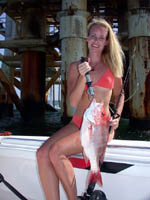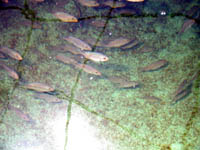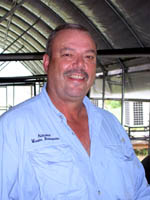
|
Features
|
|
|
|
Books
|
|
|
|
Fun & Games
|
|
|
|
Contact Us
|
|
|
John's Journal... Entry 232, Day 1
SNAPPER BONANZA
The Future Has Arrived
 Editor's
Note: The recovery of red snapper in the Gulf of Mexico and possibly worldwide
may occur much quicker than previously predicted, thanks to a small group
of scientists at the Claude Peteet Mariculture Center in Gulf Shores,
Alabama. New scientific breakthroughs in artificially spawning snapper,
producing microscopic-sized food for baby snapper, training snapper to
eat commercially-prepared food, creating an artificial habitat that speeds
up the reproduction cycle of the red snapper and constructing a new salt-water
pipeline from the Gulf of Mexico to the Mariculture Center may result
in the Center's producing 100,000 red snapper per year for restocking
and research within the next five years.
Editor's
Note: The recovery of red snapper in the Gulf of Mexico and possibly worldwide
may occur much quicker than previously predicted, thanks to a small group
of scientists at the Claude Peteet Mariculture Center in Gulf Shores,
Alabama. New scientific breakthroughs in artificially spawning snapper,
producing microscopic-sized food for baby snapper, training snapper to
eat commercially-prepared food, creating an artificial habitat that speeds
up the reproduction cycle of the red snapper and constructing a new salt-water
pipeline from the Gulf of Mexico to the Mariculture Center may result
in the Center's producing 100,000 red snapper per year for restocking
and research within the next five years.
 "Last
year the Center produced 2,000 red snapper, and this year we expect to
produce 20,000 red snapper," Vernon Minton, chief of Marine Resources
for Alabama's Department of Conservation, says. The federal government
helped the Center build a pipeline from the Gulf of Mexico to the facility,
approximately 5-miles away. "With this new unlimited supply of salt water,
we expect our production of red snapper to jump by tenfold this year,"
Minton explains. "In the past, we've had to truck salt water to the Center
to keep a very-limited supply of salt water.
"Last
year the Center produced 2,000 red snapper, and this year we expect to
produce 20,000 red snapper," Vernon Minton, chief of Marine Resources
for Alabama's Department of Conservation, says. The federal government
helped the Center build a pipeline from the Gulf of Mexico to the facility,
approximately 5-miles away. "With this new unlimited supply of salt water,
we expect our production of red snapper to jump by tenfold this year,"
Minton explains. "In the past, we've had to truck salt water to the Center
to keep a very-limited supply of salt water.
 "We've
already proven that we can spawn and grow red snapper in captivity and
restock them successfully in the wild. A good percentage of these snapper
will stay on the reefs where they're stocked. Researchers now can grow
red snapper quicker to stock more red snapper in the Gulf of Mexico and
to learn more about the life history of the stocked red snapper. Hopefully
scientists can help recover red snapper worldwide through systematic restocking
of reefs with nonexistent or dangerously low red snapper populations.
The next step is to refine our techniques and increase our capacity so
that the Mariculture Center can grow red snapper quickly to stock more
red snapper in the Gulf of Mexico faster and to learn more about the life
history of the red snapper we stock. One day we may be able to help speed
up the recovery of the red snapper in the Gulf of Mexico and worldwide
through systematic restocking of reefs where the red snapper populations
are nonexistent or dangerously low."
"We've
already proven that we can spawn and grow red snapper in captivity and
restock them successfully in the wild. A good percentage of these snapper
will stay on the reefs where they're stocked. Researchers now can grow
red snapper quicker to stock more red snapper in the Gulf of Mexico and
to learn more about the life history of the stocked red snapper. Hopefully
scientists can help recover red snapper worldwide through systematic restocking
of reefs with nonexistent or dangerously low red snapper populations.
The next step is to refine our techniques and increase our capacity so
that the Mariculture Center can grow red snapper quickly to stock more
red snapper in the Gulf of Mexico faster and to learn more about the life
history of the red snapper we stock. One day we may be able to help speed
up the recovery of the red snapper in the Gulf of Mexico and worldwide
through systematic restocking of reefs where the red snapper populations
are nonexistent or dangerously low."
To learn more about this program at the Marine Resources Division, e-mail Minton at rvminton@gulftel.com, and you also can visit www.dcnr.state.al.us/mr/cpmc.htm on the Web.
TOMORROW: THE PROBLEM WITH RAISING CAPTIVE RED SNAPPER:
PRODUCING FOOD FOR THE FRY
Check back each day this week for more about SNAPPER BONANZA ...
Day 1 - The Future Has Arrived
Day 2 - The Problem With Raising Captive
Red Snapper: Producing Food For the Fry
Day 3 - Two Ways To Spawn Snapper: Artificially
and By Creating Habitat
Day 4 - The Future of Red Snapper
Day 5 - Snapper As An Aquaculture Fish